Experimental Research on a Needle Roller-Type Electrostatic Separation Device for Separating Unginned Cotton and Residual Films
Abstract
:1. Introduction
2. Device and Methods
2.1. Design and Construction of the Needle Roller-Type Unginned Residual Film Electrostatic Separation Device
2.2. Material Charge Tests
2.3. Test Method for Separation of the Residual Film from Unginned Cotton
3. Results and Discussion
3.1. Force Analyses of Charged Materials
3.2. Results and Analyses of the Charge Tests performed on the Seed Cotton and Residual Film
3.3. Test Results and Analyses for Separation of the Residual Film from the Unginned Cotton
3.3.1. Effect of Electrode Position and Operating Parameters on the Separation Rate
3.3.2. Response Surface Test for Electrostatic Separation of the Residual Film from the Unginned Cotton
3.3.3. Determination and Verification of the Optimal Parameters
4. Conclusions
- Based on the principles of corona charge and induction charge, a pin-roller electrostatic separation device was designed and used to separate the residual film in cotton during processing.
- Corona electrodes were used to charge the materials, and electrostatic electrodes were used to form the electric fields. During operation, the electrostatic electrode repelled the negative residual film and attracted the positive unginned cotton, so the composite electrode structure with the corona electrode and the static electrode improved the separation efficiency.
- The conductive properties of the unginned cotton and the residual film were investigated with material charge tests. The results showed that the unginned cotton with a moisture content of approximately 10% served as a conductor, so it contacted the electrode of the ground roller after charging and then carried a positive charge due to the influence of inductive charging. The residual film was a nonconductor, and the charge was not easily lost under the action of the electric image force, so the film continued to adsorb onto the ground roller electrode.
- In the high-voltage electrostatic field of the corona discharge, the unginned cotton and residual film underwent quick and complete instantaneous charging during free fall through the ionization environment without deliberately increasing the charging time of the material. For 12 random samples, the average charge on the residual films was −32.91 nC. The average charge of the unginned cotton that did not contact the ground electrode was −3.54 nC and that of the unginned cotton that did contact the ground electrode was 1.18 nC (positive value).
- The results of the single factor tests showed that the optimal parameters for the separation of unginned cotton and residual film were in the following ranges; corona electrode angles of 15°–35°, corona electrode distances of 142.5 mm–212.5 mm, and discharge powers of 3.75 W–5.25 w.
- The orthogonal test results show that the optimal parameter combination included a corona electrode angle of 25.3°, a corona electrode distance of 172.3 mm, and a discharge power of 5.25 W. In the optimization test, the separation rate reached 91.7%. These results showed that the needle roller-type electrostatic separation device met the design requirements for separating unginned cotton and residual films and the agronomic requirements for actual production.
Author Contributions
Funding
Institutional Review Board Statement
Data Availability Statement
Acknowledgments
Conflicts of Interest
References
- Ren, W.; Du, Y.; Zuo, H. Research progress in image segmentation and edge detection methods for alien fibers detection in cotton. J. Text. Res. 2021, 42, 196–204. [Google Scholar] [CrossRef]
- Wu, J.; Chen, X. Current situation, problems and countermeasures of cotton production mechanization development in Xinjiang Corps. Chin. J. Agric. Eng. 2015, 31, 5–10. [Google Scholar] [CrossRef]
- Liang, R.; Chen, X.; Zhang, B. Current situation and countermeasures of the recovery methods and resource reuse of residual film in cotton fields in Xinjiang. Chin. J. Agric. Eng. 2019, 35, 1–13. [Google Scholar] [CrossRef]
- Kan, Z.; Guo, W.; Zhang, R. Design of reticulated drum machine-unginned cotton residual membrane separator. Chin. J. Agric. Eng. 2011, 27, 95–99. [Google Scholar] [CrossRef]
- Li, H.; Wang, H. Multi-objective adaptive control model of foreign fiber cleaner used in seed cotton. Chin. J. Agric. Eng. 2015, 31, 39–46. [Google Scholar] [CrossRef]
- Liu, X.; Zhou, Y.; Zhao, Y. The current situation and prospect of the development of cotton foreign fiber cleaning machinery. Jiangsu Agric. Sci. 2011, 39, 505–506. [Google Scholar] [CrossRef]
- Peng, Q.; Li, C.; Kang, J. Improved design and experiment of pneumatic cylindrical sieve membrane hybrid separator. J. Agric. Mach. 2020, 51, 126–135. [Google Scholar] [CrossRef]
- Ni, C.; Li, Z.; Zhang, X. Unginned cotton mulch sorting algorithm based on short-wave near-infrared hyperspectral and deep learning. J. Agric. Mach. 2019, 50, 170–179. [Google Scholar] [CrossRef]
- Yu, J.; Li, C. mRMR-based feature selection for classification of cotton foreign matter using hyperspectral imaging. Comput. Electron. Agric. 2015, 119, 191–200. [Google Scholar] [CrossRef]
- Kuzy, J.; Li, C. A pulsed thermographic imaging system for detection and identification of cotton foreign matter. Sensors 2017, 17, 518. [Google Scholar] [CrossRef] [Green Version]
- Zhang, M.; Li, C.; Yang, F. Classification of foreign matter embedded inside cotton lint using short wave infrared (SWIR) hyperspectral transmittance imaging. Comput. Electron. Agric. 2017, 139, 75–90. [Google Scholar] [CrossRef]
- De Oliveira, C.M.; Bellopede, R.; Tori, A.; Zanetti, G.; Marini, P. Gravity and Electrostatic Separation for Recovering Metals from Obsolete Printed Circuit Board. Materials 2022, 15, 1874. [Google Scholar] [CrossRef]
- Suponik, T.; Franke, D.M.; Nuckowski, P.M.; Matusiak, P.; Tora, B. Impact of grinding of printed circuit boards on the efficiency of metal recovery by means of electrostatic separation. Minerals 2021, 11, 281. [Google Scholar] [CrossRef]
- Zhang, Z.; Cui, Z.; Yang, J.; Yue, Z.; Wei, Y. Optimization of electrostatic separation of Si and PET in waste solar panels. China Environ. Sci. 2017, 37, 3048–3055. [Google Scholar] [CrossRef]
- Salama, A.; Richard, G.; Medles, K.; Zeghloul, T.; Dascalescu, L. Distinct recovery of copper and aluminum from waste electric wires using a roll-type electrostatic separator. Waste Manag. 2018, 76, 207–216. [Google Scholar] [CrossRef]
- Xu, A.; Niu, X.; Hu, Y.; Yang, Y. Study on adsorption efficiency of electrostatic residual membrane separation device. Jiangsu Agric. Sci. 2017, 45, 204–207. [Google Scholar] [CrossRef]
- Xu, A.; Ma, S.; Hu, Y.; Niu, X. Effects of moisture content and voltage on the efficiency of electrostatic separation devices. Res. Agric. Mech. 2017, 45, 204–207. [Google Scholar] [CrossRef]
- Qi, Y.; Yang, Y.; Wang, Y. Residual membrane electrostatic adsorption experimental study on the recovery unit. J. Agric. Mech. Res. 2021, 43, 164–168. [Google Scholar] [CrossRef]
- Guo, S.; Kan, Z.; Zhang, R.; Guo, W. Separation test of electrostatic separation device for mechanically harvested unginned cotton residual film. Chin. J. Agric. Eng. 2011, 27, 6–10. [Google Scholar] [CrossRef]
- Wang, Q.; Weng, F.; Zhang, H.; Yuan, C.; Li, L. Grading removal of residual plastic film in machine-harvested cotton using electrostatic adsorption method. Trans. Chin. Soc. Agric. Mach. 2019, 50, 140–147. [Google Scholar]
- Labair, H.; Touhami, S.; Tilmatine, A.; Hadjeri, S.; Medles, K.; Dascalescu, L. Study of charged particles trajectories in free-fall electrostatic separators. J. Electrost. 2017, 88, 10–14. [Google Scholar] [CrossRef]
- Xue, M.; Yan, G.; Li, J.; Xu, Z. Electrostatic separation for recycling conductors, semiconductors, and nonconductors from electronic waste. Environ. Sci. Technol. 2012, 46, 10556–10563. [Google Scholar] [CrossRef]
- Li, M.; Hu, W.; Gong, W. Influence of electrode structure on the electric field of YD electro-separator. Min. Metall. Eng. 2016, 36, 30–32. [Google Scholar]
- Peng, Z.; Yang, X.; Wang, H.; Zhang, G.; Yang, J.; Zhao, X. Research on friction electrostatic separation of ilmenite. Met. Mines 2018, 02, 80–84. [Google Scholar] [CrossRef]
- Richard, G.; Salama, A.; Medles, K.; Zeghloul, T.; Dascalescu, L. Comparative study of three high-voltage electrode configurations for the electrostatic separation of aluminum, copper and PVC from granular WEEE. J. Electrost. 2017, 88, 29–34. [Google Scholar] [CrossRef]
- Chen, Z.; Xia, Q.; Huang, Q. Study on electrical properties of wheat bran structure layer powder. Chin. J. Agric. Eng. 2020, 36, 303–309. [Google Scholar] [CrossRef]
- Jafari, M.; Chegini, G.; Akmal, A.A.S.; Rezaeealam, B. A roll-type corona discharge–electrostatic separator for separating wheat grain and straw particles. J. Food Process Eng. 2019, 42, e13281. [Google Scholar] [CrossRef]
- Zhang, X.; Su, Y.; Yi, J. Experimental study on the effect of rubbing pretreatment on shelling of Penaeus vannamei. Chin. J. Agric. Eng. 2021, 37, 307–315. [Google Scholar] [CrossRef]
- Yang, S.; Chen, X.; Yan, L. Design and experiment of a belt-type film reel device for residual film recovery machine. J. Agric. Mach. 2021, 52, 135–144. [Google Scholar] [CrossRef]
- Li, F.; Xing, S.; Tian, F. Design and experiment of tooth roller type forage crop preparation test bench. J. Agric. Mach. 2021, 52, 136–147. [Google Scholar] [CrossRef]
- Li, Q.; Liu, X.; Ju, X. Influencing factors of ion distribution under needle-plate electrode negative corona discharge. High Volt 2017, 43, 1700–1706. [Google Scholar] [CrossRef]
- Ge, Y. Experimental Design Method and Application of Design-Expert Software; Harbin Institute of Technology Press: Harbin, China, 2015; pp. 62–95. [Google Scholar]
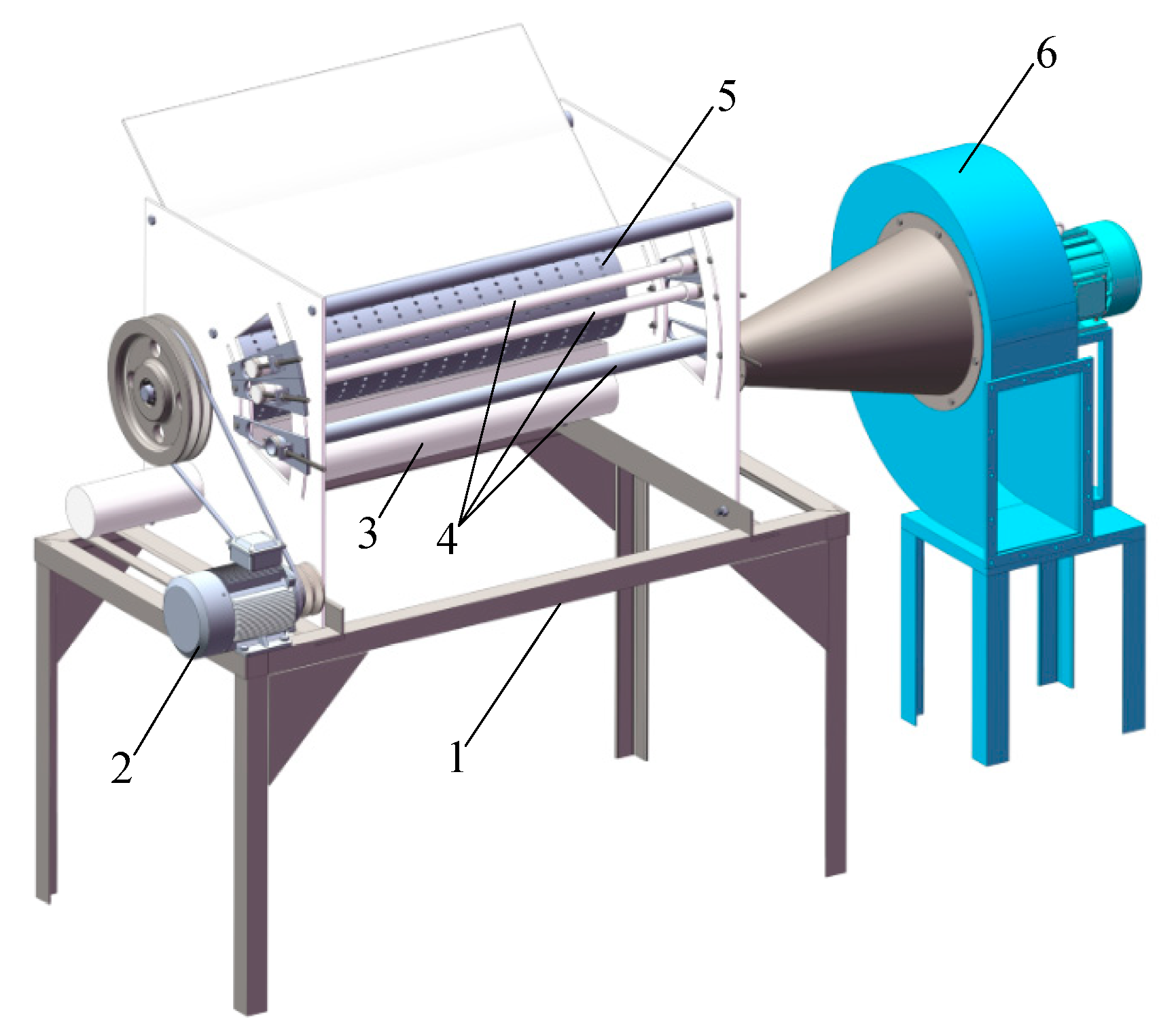
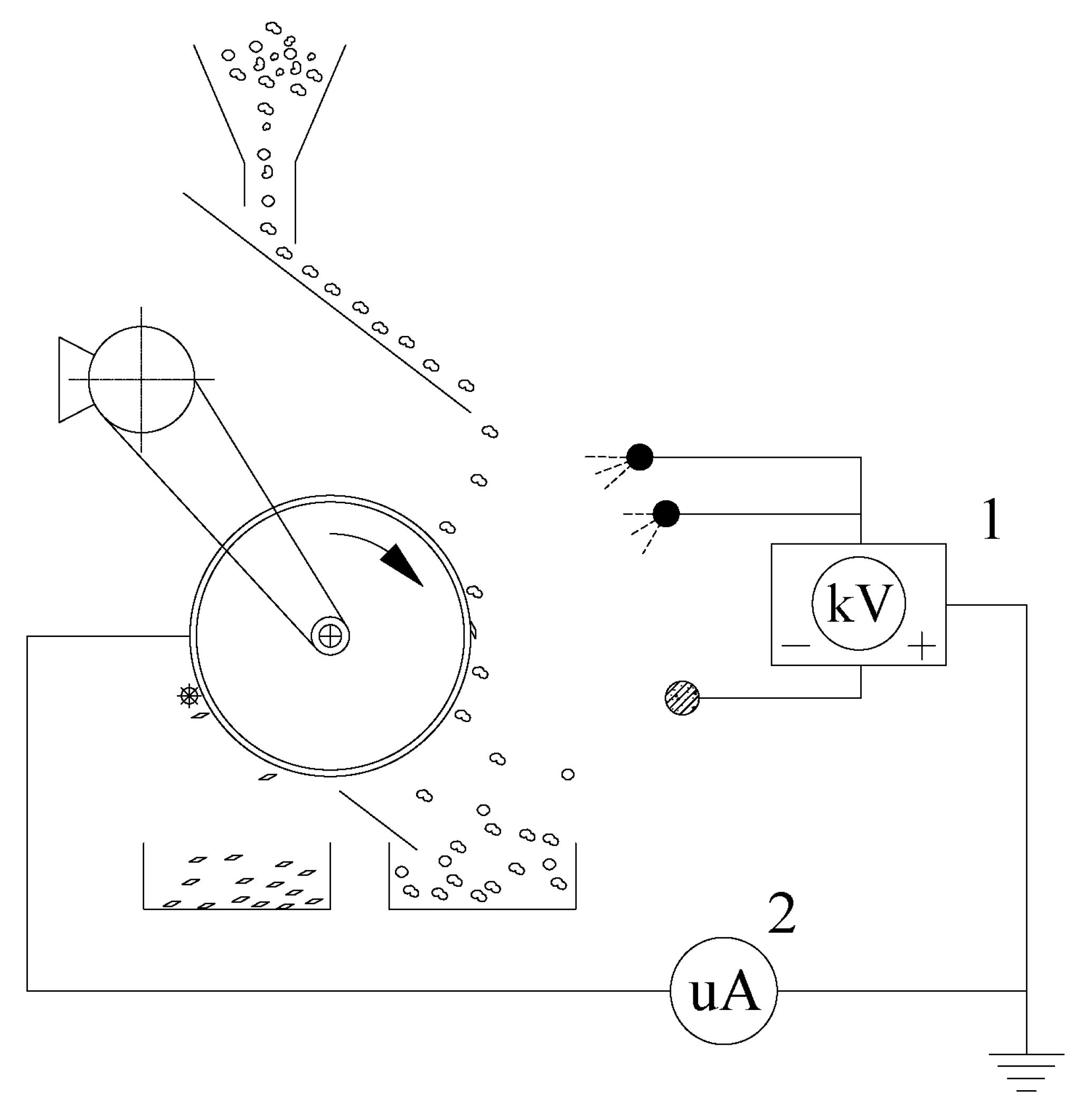
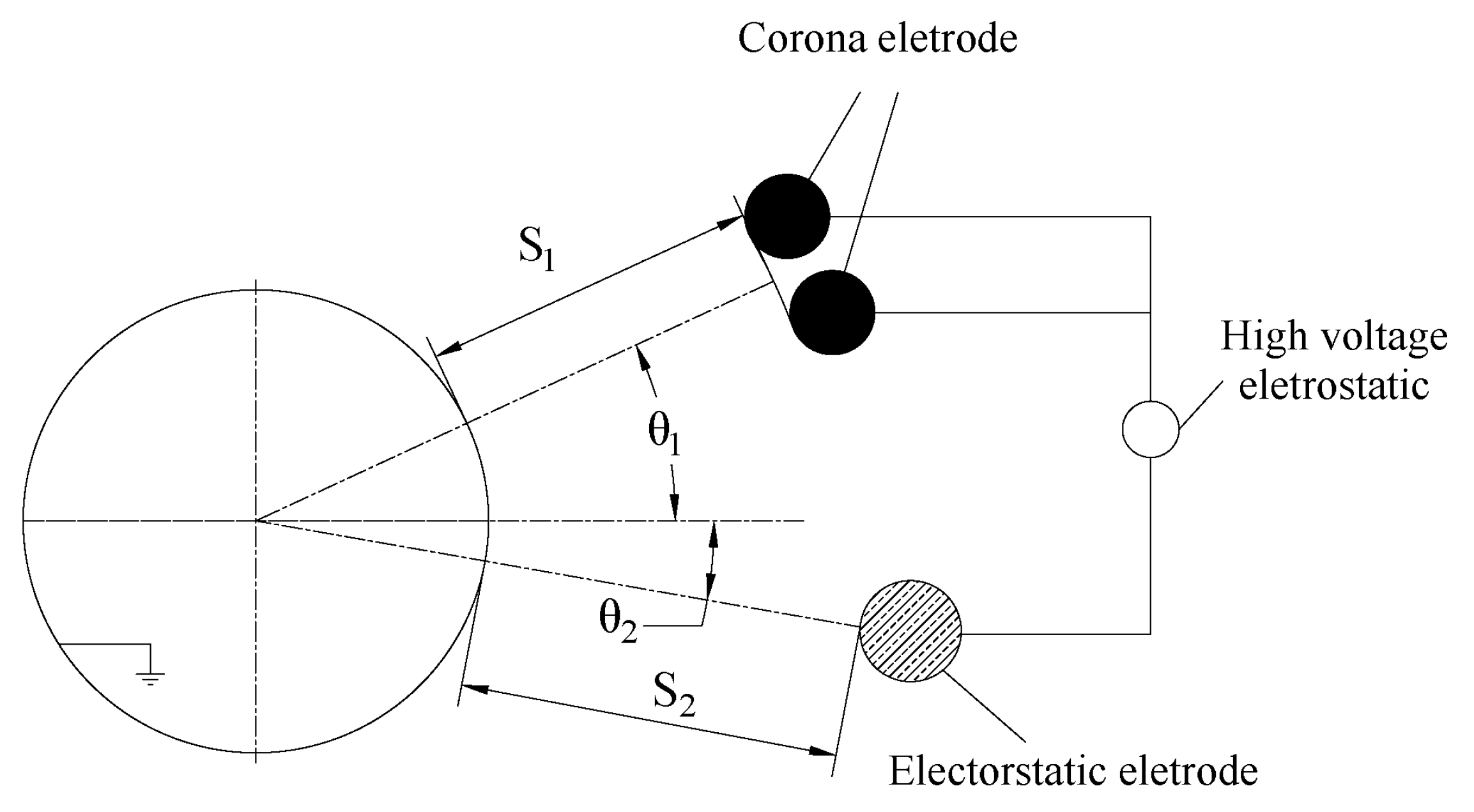
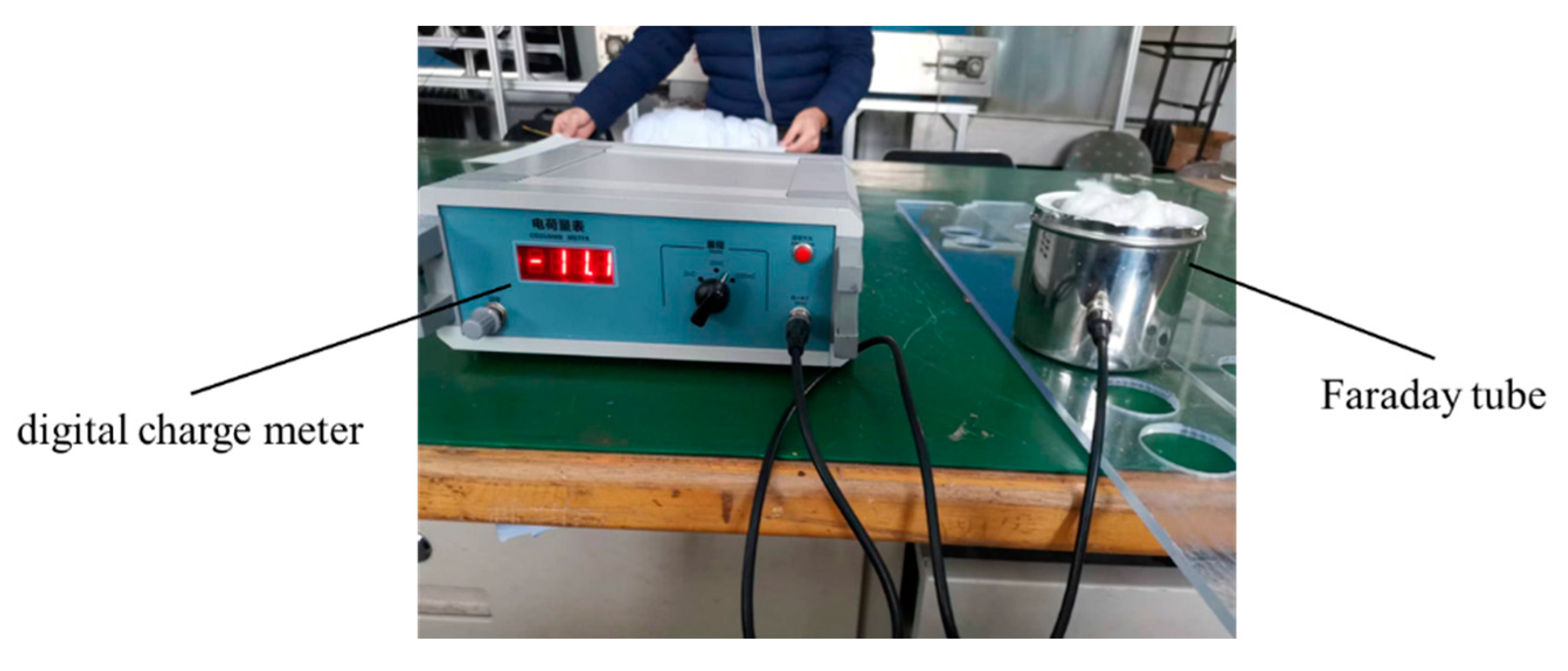
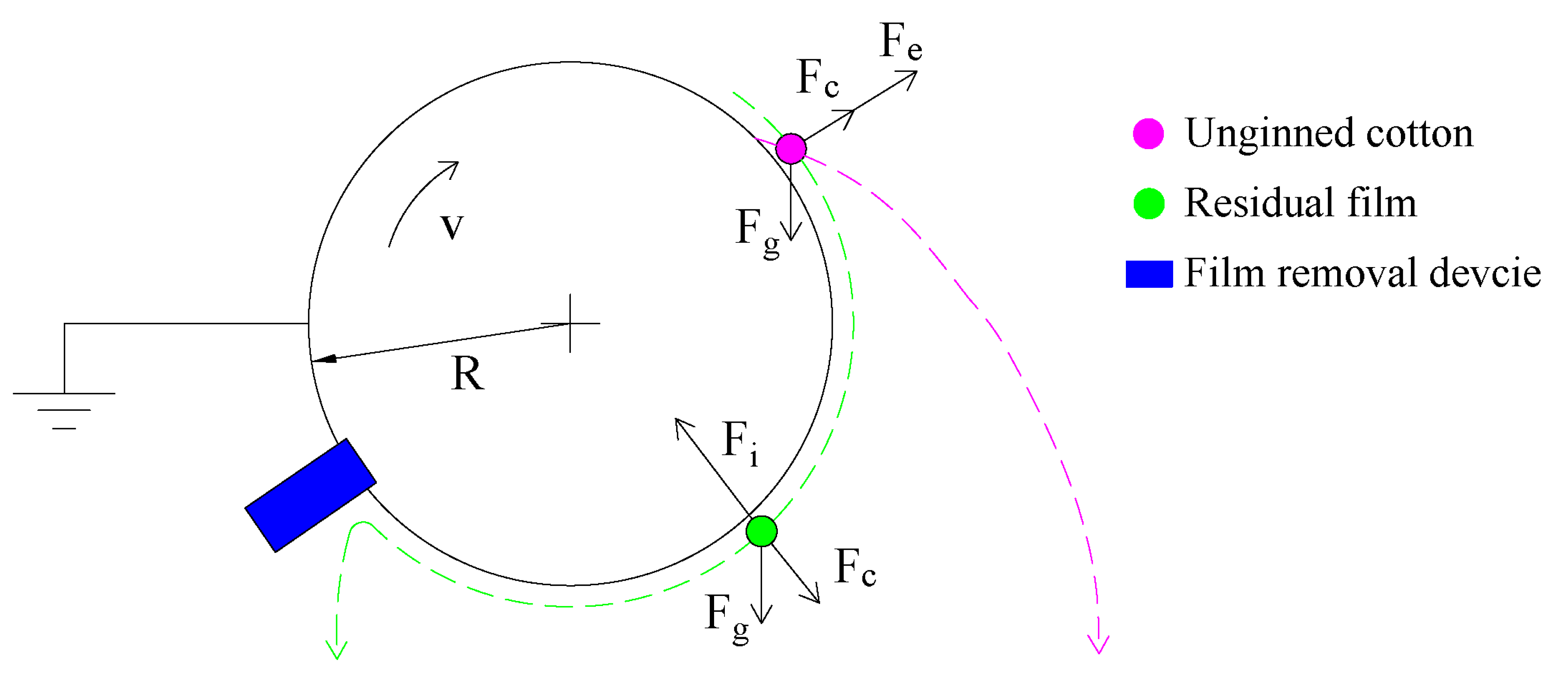


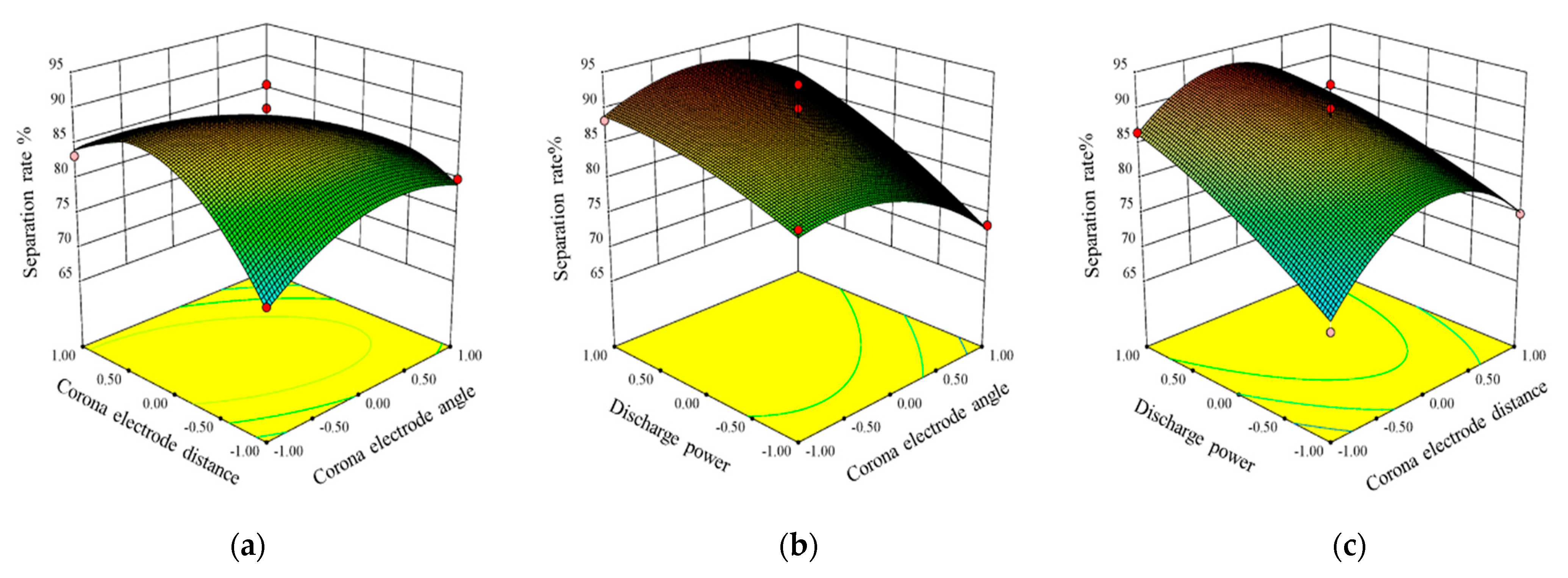
| Factor | Level | ||
|---|---|---|---|
| −1 | 0 | 1 | |
| Corona electrode angle A/° | 15 | 25 | 35 |
| Corona electrode distance B/mm | 142.5 | 177.5 | 212.5 |
| Discharge power C/w | 3.75 | 4.5 | 5.25 |
| Unginned Cotton | Residual Film | ||||||
|---|---|---|---|---|---|---|---|
| Sample NO. | Instantaneous Charge (nC) | Loss of Charge State (nC) | Saturated Charge (nC) | Sample Area (mm2) | Instantaneous Charge (nC) | Saturated Charge (nC) | |
| 1 | −3.97 | 1.17 | −8.33 | 0.0045 | −28.73 | −31.73 | |
| 2 | −3.77 | 1.10 | −6.63 | 0.0050 | −34.80 | −36.93 | |
| 3 | −3.27 | 1.03 | −4.60 | 0.0045 | −27.73 | −42.47 | |
| 4 | −3.07 | 1.10 | −7.13 | 0.0050 | −34.27 | −36.67 | |
| 5 | −4.00 | 1.33 | −6.63 | 0.0055 | −37.47 | −40.57 | |
| 6 | −3.17 | 1.33 | −9.43 | 0.0050 | −34.50 | −38.53 | |
| Mean value | −3.54 | 1.18 | −7.13 | −32.91 | −37.81 | ||
| Test No. | Corona Electrode Angle A/° | Corona Electrode Distance B/mm | Discharge Power C/w | Separation Rate Y/% |
|---|---|---|---|---|
| 1 | 1 | 0 | 1 | 86.7 |
| 2 | 1 | −1 | 0 | 80.0 |
| 3 | −1 | 0 | −1 | 83.3 |
| 4 | 1 | 1 | 0 | 66.7 |
| 5 | 0 | 1 | 1 | 83.3 |
| 6 | 0 | −1 | 1 | 86.7 |
| 7 | 0 | 0 | 0 | 90.0 |
| 8 | −1 | 1 | 0 | 83.3 |
| 9 | −1 | 0 | 1 | 88.3 |
| 10 | 1 | 0 | −1 | 73.3 |
| 11 | 0 | 0 | 0 | 86.7 |
| 12 | −1 | −1 | 0 | 73.3 |
| 13 | 0 | 0 | 0 | 86.7 |
| 14 | 0 | −1 | −1 | 70.0 |
| 15 | 0 | 0 | 0 | 93.3 |
| 16 | 0 | 0 | 0 | 86.7 |
| 17 | 0 | 1 | −1 | 75.0 |
| Sources | Sum of Squares | df | Mean Square | F Value | p Value |
|---|---|---|---|---|---|
| Model | 885.69 | 9 | 98.41 | 15.78 | 0.0007 |
| A | 57.78 | 1 | 57.78 | 9.27 | 0.0187 |
| B | 0.36 | 1 | 0.36 | 0.058 | 0.8167 |
| C | 235.45 | 1 | 235.45 | 37.75 | 0.0005 |
| AB | 135.72 | 1 | 135.72 | 21.76 | 0.0023 |
| AC | 17.64 | 1 | 17.64 | 2.83 | 0.1365 |
| BC | 17.64 | 1 | 17.64 | 2.83 | 0.1365 |
| A^2 | 79.77 | 1 | 79.77 | 12.79 | 0.009 |
| B^2 | 304.39 | 1 | 304.39 | 48.81 | 0.0002 |
| C^2 | 8.58 | 1 | 8.58 | 1.38 | 0.2792 |
| Residual | 43.66 | 7 | 6.24 | ||
| Lack of Fit | 8.81 | 3 | 2.94 | 0.34 | 0.8009 |
| Pure Error | 34.85 | 4 | 8.71 | ||
| Cor Total | 929.34 | 16 |
Disclaimer/Publisher’s Note: The statements, opinions and data contained in all publications are solely those of the individual author(s) and contributor(s) and not of MDPI and/or the editor(s). MDPI and/or the editor(s) disclaim responsibility for any injury to people or property resulting from any ideas, methods, instructions or products referred to in the content. |
© 2023 by the authors. Licensee MDPI, Basel, Switzerland. This article is an open access article distributed under the terms and conditions of the Creative Commons Attribution (CC BY) license (https://creativecommons.org/licenses/by/4.0/).
Share and Cite
Sun, Y.; Hu, C.; Li, Y.; Chen, M.; Zhang, R. Experimental Research on a Needle Roller-Type Electrostatic Separation Device for Separating Unginned Cotton and Residual Films. Agriculture 2023, 13, 324. https://doi.org/10.3390/agriculture13020324
Sun Y, Hu C, Li Y, Chen M, Zhang R. Experimental Research on a Needle Roller-Type Electrostatic Separation Device for Separating Unginned Cotton and Residual Films. Agriculture. 2023; 13(2):324. https://doi.org/10.3390/agriculture13020324
Chicago/Turabian StyleSun, Yue, Chunling Hu, Yangyang Li, Mingxiao Chen, and Ruoyu Zhang. 2023. "Experimental Research on a Needle Roller-Type Electrostatic Separation Device for Separating Unginned Cotton and Residual Films" Agriculture 13, no. 2: 324. https://doi.org/10.3390/agriculture13020324





